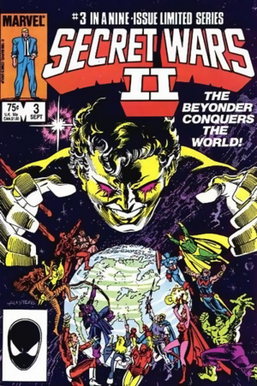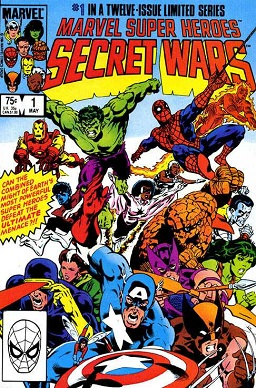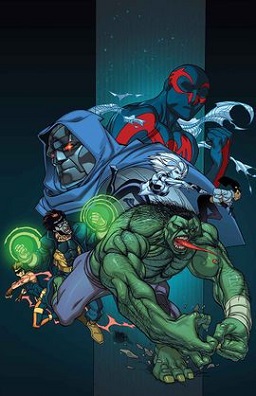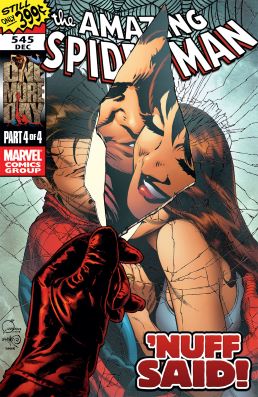Related Research Articles

The Marvel Universe is a fictional shared universe where the stories in most American comic book titles and other media published by Marvel Comics take place. Super-teams such as the Avengers, the X-Men, the Fantastic Four, the Guardians of the Galaxy, and many Marvel superheroes live in this universe, including characters such as Spider-Man, Captain America, Iron Man, Thor, the Hulk, Ant-Man, the Wasp, Wolverine, Black Panther, Doctor Strange, Daredevil, and Captain Marvel, Blade, Black Widow, Hawkeye, among numerous others. It also contains well-known supervillains such as Doctor Doom, Magneto, Ultron, Thanos, Loki, The Green Goblin, Kang the Conqueror, Red Skull, The Kingpin, Doctor Octopus, Carnage, Apocalypse, Dormammu, Mysterio, Electro, and the Vulture. It also contains antiheroes such as Venom, Namor, Deadpool, Silver Sable, Ghost Rider, The Punisher, and Black Cat.

The Beyonder is a fictional cosmic entity appearing in American comic books published by Marvel Comics. Created by writer Jim Shooter and artist Mike Zeck, the Beyonder first appeared in Secret Wars #1 as an unseen, nigh-omnipotent being from outside the multiverse who kidnapped the heroes and villains of the Marvel Universe to have them do battle on Battleworld, a fictional planet created by the Beyonder. The character plays a more antagonistic role in the 1985 sequel, Secret Wars II, in which he takes human form to learn about desire but threatens to destroy the multiverse out of increasing frustration.

Marvel Super Heroes Secret Wars, commonly known as Secret Wars, is a 12-issue American comic book crossover limited series published from May 1984 to April 1985 by Marvel Comics. The series was written by Jim Shooter, with art by Mike Zeck and Bob Layton. It was tied in with a toy line and a role-playing game of the same name from Mattel.

Marvel Knights is an imprint of Marvel Comics that contained standalone material taking place inside the Marvel Universe (Earth-616). The imprint originated in 1998 when Marvel outsourced four titles to Joe Quesada and Jimmy Palmiotti's company Event Comics; Event hired the creative teams for the Knights line while Marvel published them.

Captain Britain is a title used by various superheroes in comic books published by Marvel Comics, commonly in association with Excalibur. The moniker was first used in publication by Brian Braddock in Captain Britain #1 by writer Chris Claremont and artist Herb Trimpe, and is currently held by Brian's twin sister, Betsy Braddock.

What If, sometimes stylized as What If…?, is a comic book anthology series published by Marvel Comics whose stories explore how the Marvel Universe might have unfolded if key moments in its history had not occurred as they did in mainstream continuity. Since What If debuted in 1977, the comics have been published in 14 series as well as occasional stand-alone issues. In 2024, Marvel announced that What If…? would expand to include alternate explorations of continuity within other non-Marvel Universe properties owned by their parent company The Walt Disney Company from its fifteenth volume onwards, beginning with Aliens: What If…?, based on the Alien franchise.

Marvel 2099 was a Marvel Comics imprint, started in 1992, that was originally about one possible future of the Marvel Universe, but later revealed to be the Earth of the main Marvel continuity in the distant future. It was originally announced by Stan Lee in his "Stan's Soapbox" column as a single series entitled The Marvel World of Tomorrow, which was being developed by Lee and John Byrne. This later changed to a line of books under the banner Marvel 2093 before finally being published as Marvel 2099.

Ultimate Marvel, later known as Ultimate Comics, was an imprint of comic books published by Marvel Comics, featuring reimagined and modernized versions of the company's superhero characters from the Ultimate Marvel Universe, later known as the Ultimate Universe. Those characters include Spider-Man, the X-Men, the Ultimates, the Fantastic Four, and others. The imprint was launched in 2000 with the publication of the series Ultimate Spider-Man and Ultimate X-Men in 2001, followed by The Ultimates and Ultimate Fantastic Four in 2002 and 2004 respectively providing new origin stories for the characters. The reality of Ultimate Marvel is designated as Earth-1610 as part of the Marvel Comics Multiverse.

The Time Variance Authority (TVA) is a fictional organization appearing in American comic books published by Marvel Comics. It is depicted as a group of timeline monitors tasked with preventing certain timelines that are deemed too dangerous to the Multiverse from existing.
American comic book tropes are common elements and literary devices related to American comic books.
Dave Thorpe is a British writer who is best known for his work on Captain Britain.
Opal Luna Saturnyne is a fictional character appearing in American comic books published by Marvel Comics. The character was created by Dave Thorpe and Alan Davis for their Captain Britain stories. Formerly the servant of Roma, she is currently the Omniversal Majestrix and rightful Ruler of Otherworld, charged with the safety of the Omniverse.

Jaspers' Warp, sometimes referred to as Crooked World, is a superhero comic book storyline from the British Captain Britain strip printed across several Marvel UK titles between 1981 and 1984.
Within Marvel Comics, most tales take place within the fictional Marvel Universe, which in turn is part of a larger multiverse. Starting with issues of Captain Britain, the main continuity in which most Marvel storylines take place was designated Earth-616, and the Multiverse was established as being protected by Merlyn. Each universe has a Captain Britain designated to protect its version of the British Isles. These protectors are collectively known as the Captain Britain Corps. This numerical notation was continued in the series Excalibur and other titles. Each universe of the Multiverse in Marvel also appears to be defended by a Sorcerer Supreme at nearly all times, appointed by the mystic trinity of Vishanti to defend the world against threats primarily magical in nature from within and beyond and bearing the Eye of Agamotto.

The Special Executive is a fictional group of time-traveling mercenaries appearing in American comic books published by Marvel Comics. The characters were decpicted in comic strips published by Marvel UK. The initial incarnation was created by Alan Moore and David Lloyd for Doctor Who Monthly; Alan Davis later expanded the line-up when they appeared in Captain Britain.
Jester is the name of three supervillains appearing in American comic books published by Marvel Comics.

"One More Day" (OMD) is a four-part 2007 comic book crossover storyline, connecting the three main Spider-Man series published by Marvel Comics at the time. Written by J. Michael Straczynski and Joe Quesada, with art by Quesada, the story arc concludes the fallout of Spider-Man's actions during the 2007 Civil War crossover. "One More Day" starts in The Amazing Spider-Man #544, continues in Friendly Neighborhood Spider-Man #24 and The Sensational Spider-Man #41, and concludes in The Amazing Spider-Man #545.

"Secret Wars" is a 2015–16 comic book storyline published by Marvel Comics. It recalls the 1984–1985 miniseries of the same name. Released on May 6, 2015, the storyline includes a core Secret Wars miniseries, written by Jonathan Hickman and drawn by Esad Ribić, which picks up from where the "Time Runs Out" storyline running in The Avengers and New Avengers ended. The event also served as a conclusion to the Fantastic Four after Marvel decided to cancel the title due to a film rights dispute with 20th Century Fox and declining sales.

The multiverse is a fictional setting within the Marvel Cinematic Universe (MCU) media franchise. Based on the setting of the same name from the Marvel Comics, it is a collection of infinitely many alternate realities and dimensions. First explored in the film Doctor Strange (2016), it is revisited in the film Avengers: Endgame (2019) before playing a key role in Phase Four, Phase Five, and Phase Six of the franchise, which constitute "The Multiverse Saga". In the MCU, the Multiverse centers around a single universe called the "Sacred Timeline", whose native Time Variance Authority (TVA) has taken measures to prevent any branching universes from forming. However, following the death of the TVA's hidden overseer, a Kang the Conqueror variant known as "He Who Remains", in the Loki season 1 finale "For All Time. Always.", the Sacred Timeline is broken and an infinite number of universes are formed, and certain residents in the Sacred Timeline gain the ability to travel to different universes.
Brian Braddock is a fictional superhero appearing in British and American comic books published by Marvel Comics. Created in 1976 by writer Chris Claremont and artist Herb Trimpe, with later contributions from Alan Moore and Alan Davis, he first appeared in Captain Britain Weekly #1. He is the first character in publication to use the Captain Britain moniker, later adopting the title Captain Avalon.
References
- ↑ Babos, John (August 6, 2011). "Marvel's New Ultimate Spider-Man Miles Morales: A Significant And Safe Leap Forward". Comic Nexus.
- ↑ Tom Brevoort (May 29, 2007). "Marvel.com Blogs - Blah Blah Blog by Tom Brevoort". Archived from the original on December 11, 2008. Retrieved August 21, 2019.
- 1 2 Rich Johnston (July 2, 2019). "Dave Thorpe, the Man Who Invented Marvel's "616", Explains Where It Came From". Bleeding Cool . Retrieved March 6, 2023.
- ↑ "'Thor: The Dark World' Easter Eggs, Trivia & References". Screen Rant. November 11, 2013. Retrieved March 21, 2017.
- ↑ "Iron Fist Season 2 Gives a Clever Nod to the Marvel Multiverse". Comic Book Resources. September 7, 2018. Retrieved February 21, 2022.
- ↑ "Marvel Multiverse Easter Egg Discovered in Avengers: Endgame". MovieWeb. August 5, 2019. Retrieved May 18, 2022.
- ↑ Kleinman, Jake. "Earth-616? 'Doctor Strange 2' just changed a foundational fact about the MCU". Inverse. Retrieved May 7, 2022.
- ↑ "DOCTOR STRANGE 2: The MCU's Marvel Universe Numbering System, Explained". Nerdist. May 6, 2022. Retrieved May 7, 2022.
- ↑ Johnston, Rich (January 13, 2016). "Tom Brevoort Confirms 'No More 616' - And It's The Last Fantastic Four Story". Bleeding Cool . Retrieved April 15, 2023.
- ↑ Quesada, Joe (2007). "New Joe Fridays – Week 44, A Weekly Q&A with Joe Quesada". Newsarama. Archived from the original on June 23, 2007.